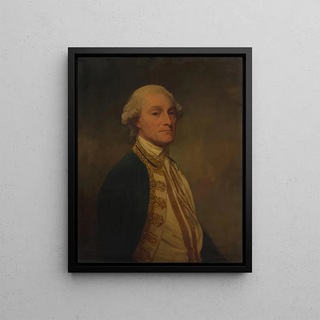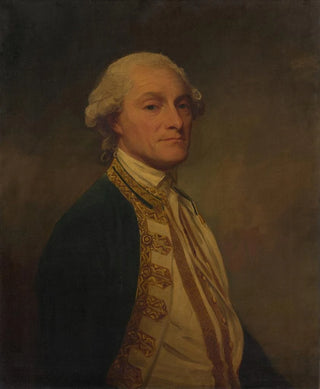Art print | Admiral Sir Chaloner Ogle - George Romney


View from behind

Frame (optional)
George Romney's art print "Admiral Sir Chaloner Ogle" is a true testament to 18th-century British art, a period when portrait painting reached heights of sophistication and elegance. This artwork, which captures the very essence of its subject, immerses us in a universe where identity and social status intertwine with artistic virtuosity. Sir Chaloner Ogle, a statesman and admiral of the Royal Navy, is depicted here with a dignity and presence that transcend time. The soft light caressing his face and the refined details of his uniform testify to a technical mastery that has made Romney renowned. Through this art print, the artist invites us to explore not only the character of his model but also the values and aspirations of a rapidly changing era.
Style and uniqueness of the art print
George Romney's style is characterized by a blend of realism and idealism. In "Admiral Sir Chaloner Ogle," he manages to strike a delicate balance between faithful representation of the subject and stylistic embellishment that lends an almost heroic aura to his model. The composition is carefully thought out, with particular attention paid to clothing details and accessories, which serve as symbols of military authority. The colors, chosen with care, harmonize to create an atmosphere that is both solemn and engaging. The play of light, in particular, accentuates the admiral's face, making his expression both serious and approachable. This ability to capture the soul of a man while celebrating his status is what makes this art print so unique and timeless.
The artist and his influence
George Romney, born in 1734, is one of the most influential portraitists of his time. His art print has marked a generation of artists and continues to inspire those venturing into portraiture. Romney succeeded in establishing himself through his impeccable technique and his ability to forge an emotional connection with his subjects. By painting prominent personalities of his era, he not only documented the social and political history of Great Britain but also helped define aesthetic standards.

Matte finish

View from behind

Frame (optional)
George Romney's art print "Admiral Sir Chaloner Ogle" is a true testament to 18th-century British art, a period when portrait painting reached heights of sophistication and elegance. This artwork, which captures the very essence of its subject, immerses us in a universe where identity and social status intertwine with artistic virtuosity. Sir Chaloner Ogle, a statesman and admiral of the Royal Navy, is depicted here with a dignity and presence that transcend time. The soft light caressing his face and the refined details of his uniform testify to a technical mastery that has made Romney renowned. Through this art print, the artist invites us to explore not only the character of his model but also the values and aspirations of a rapidly changing era.
Style and uniqueness of the art print
George Romney's style is characterized by a blend of realism and idealism. In "Admiral Sir Chaloner Ogle," he manages to strike a delicate balance between faithful representation of the subject and stylistic embellishment that lends an almost heroic aura to his model. The composition is carefully thought out, with particular attention paid to clothing details and accessories, which serve as symbols of military authority. The colors, chosen with care, harmonize to create an atmosphere that is both solemn and engaging. The play of light, in particular, accentuates the admiral's face, making his expression both serious and approachable. This ability to capture the soul of a man while celebrating his status is what makes this art print so unique and timeless.
The artist and his influence
George Romney, born in 1734, is one of the most influential portraitists of his time. His art print has marked a generation of artists and continues to inspire those venturing into portraiture. Romney succeeded in establishing himself through his impeccable technique and his ability to forge an emotional connection with his subjects. By painting prominent personalities of his era, he not only documented the social and political history of Great Britain but also helped define aesthetic standards.






